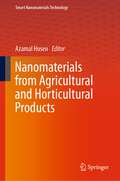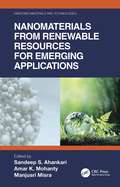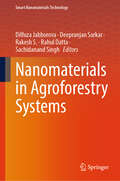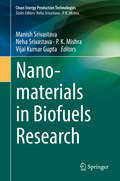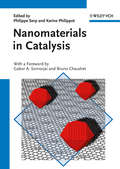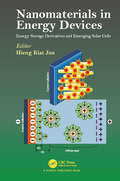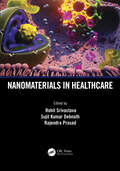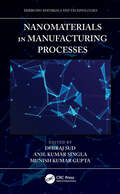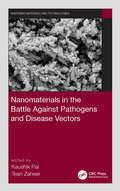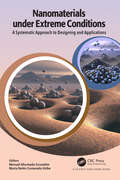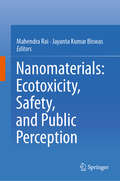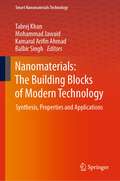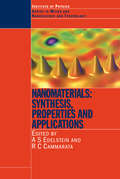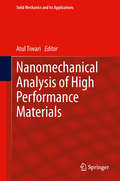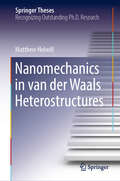- Table View
- List View
Nanomaterials from Agricultural and Horticultural Products (Smart Nanomaterials Technology)
by Azamal HusenThis book gives a complete overview of current developments in the fabrication and diverse applications of metal and metal oxide nanomaterials synthesized from agricultural/horticultural products and organic waste materials. Nanoparticles are thought to have been present on earth naturally since its origin in the form of soil, water, volcanic dust, and minerals. Besides their natural origin, they have been also synthesized by using physical, chemical, and biological means. The chapters in this book look at agricultural as well as horticultural wastes from industries, such as palm oil, rubber, paper, wood, vegetable, coffee/tea, rice, wheat, maize, grass, and fruit juice processing factories, and describe the methods to extract and synthesize metal and metal oxide nanoparticles, which are then applied in various sectors such as food, agriculture, cosmetics, and medicines industries. The book is a reference source for academician, scientists, policymakers, students, and researchers scientist working in minimizing the environmental pollution and implementing nanotechnology into agricultural waste products to produce eco-friendly and cost-effective nanoparticles.
Nanomaterials from Renewable Resources for Emerging Applications (Emerging Materials and Technologies)
by Manjusri Misra Amar K. Mohanty Sandeep S. AhankariNanomaterials from Renewable Resources for Emerging Applications details developments in nanomaterials produced from renewable materials and their usage in food and packaging, energy conservation, and environmental applications. • Introduces fundamentals of nanomaterials from renewable resources, including processing and characterization. • Covers nanomaterials for applications in food and packaging, including nanocellulose, lignin- and chitosan-based nanomaterials, and nanostarch. • Discusses applications in energy conservation, such as supercapacitors, electrolyte membranes, energy storage devices, and insulation. • Describes environmental uses such as water remediation and purification and oil spill clean-ups. • Highlights advantages and challenges in commercialization of green nanoparticle-based materials. Equally beneficial to researchers and professionals, this book is aimed at readers across materials science and engineering, chemical engineering, chemistry, and related fields interested in sustainable engineering.
Nanomaterials in Agroforestry Systems (Smart Nanomaterials Technology)
by Rahul Datta Sachidanand Singh Deepranjan Sarkar Dilfuza Jabborova Rakesh S.This book presents recent trends in nanotechnology to manage agroforestry systems. A major focus has been given to green synthesis of nanoparticles, nutrient management, stress management, crop and tree production, and risk assessment for sustainable management of crops and trees using nanomaterials. The book also discusses the complex interactions of nanoparticles in agroforestry ecosystems. It provides an understanding of the nanoparticle transformation process from laboratory to field conditions that will help in technology transfer at a mass scale. Following the excellent contributions from global experts, the book will be very useful for students, scientists, conservationists, growers, and policymakers searching for the challenges and opportunities of nanotechnology in integrated farming systems.
Nanomaterials in Biofuels Research (Clean Energy Production Technologies)
by P. K. Mishra Vijai Kumar Gupta Neha Srivastava Manish SrivastavaAs renewable energy sources, biofuels have tremendous potential to replace fossil fuels in future energy scenarios, offering green alternative energy sources. However, though such fuels could mean a significant reduction in environmental pollution, they are still far from practical implementation due to their high production costs and technical issues.Consequently, efforts are being made around the globe to achieve the cost-effective production of biofuels. In this context, the use of nanomaterials to improve biofuels production efficiency is a vital, emerging area. Nanomaterials are attracting attention due to their versatile physicochemical properties and may improve the production process for various biofuels by acting as catalysts. However, this area is still in its infancy. To improve the practical viability of the biofuels production process, it is essential to focus on the specific type of nanomaterial used, its synthesis, and its specific effects on the process parameters. This book explores the potential advantages and feasibility of various aspects of nanomaterials with regard to improving the current biofuels production process, making it a valuable resource for a broad readership.
Nanomaterials in Biomedical Application and Biosensors (Springer Proceedings in Physics #244)
by Alexander D. Pogrebnjak Maksym Pogorielov Roman ViterThis book covers novel and innovative technologies used in development, modeling, chemical/physical investigation and biomedical (in-vitro and in-vivo) trials of nanomaterials and nanocomposites. Novel methods for nanoparticle development and manufacturing are presented, as well as their safety and promising applications. In addition, the book highlights new frontiers in the use of metal / metal oxide nanoparticles, hierarchical nanostructures and organic coatings as sensors for detecting gases, inorganic and organic materials, including biosensors for bacteria and cancers. Organic nanoparticle composites for medical applications (tissue engineering, tissue replacement, regeneration, etc.), including hydroxyapatite NPs, are also covered, together with related in-vitro and preclinical investigations. In closing, the book shares recent findings on orthopedic and dental implant coatings using nanoparticles, their biological efficacy and safety.
Nanomaterials in Bionanotechnology: Fundamentals and Applications (Emerging Materials and Technologies)
by Ravindra Pratap Singh Kshitij Rb SinghNanomaterials in Bionanotechnology: Fundamentals and Applications offers a comprehensive treatment of nanomaterials in biotechnology from fundamentals to applications, along with their prospects. This book explains the basics of nanomaterial properties, synthesis, biological synthesis, and chemistry and demonstrates how to use nanomaterials to overcome problems in agricultural, environmental, and biomedical applications. Features Covers nanomaterials for environmental analysis and monitoring for heavy metals, chemical toxins, and water pollutant detection Describes nanomaterials-based biosensors and instrumentation and use in disease diagnosis and therapeutics Discusses nanomaterials for food processing and packaging and agricultural waste management Identifies challenges in nanomaterials-based technology and how to solve them This work serves as a reference for industry professionals, advanced students, and researchers working in the discipline of bionanotechnology.
Nanomaterials in Catalysis
by Karine Philippot Bruno Chaudret Gabor A. SomorjaiEdited by rising stars in the community, the team of prominent expert authors provides here authoritative first-hand information on the fundamental principles of nanomaterials, as well as their application in catalysis.As a result, the book defines the concepts of nanocatalysis and gives a comprehensive overview of the science of colloidal nanoparticles in particular. Chapters cover micelles, nanoparticles in ionic liquids, dendrimers, nanotubes, nanooxides as well as microreactors, modeling, and characterization of nanocatalysts.An indispensable reference for both researchers at universities and professionals in industry.
Nanomaterials in Drug Delivery, Imaging, and Tissue Engineering
by Ashutosh Tiwari Atul TiwariThis groundbreaking, multidisciplinary work is one of the first books to cover Nanotheragnostics, the new developmental edge of nanomedicine. Through a collection of authoritative chapters, the book reports on nanoscopic therapeutic systems that incorporate therapeutic agents, molecular targeting, and diagnostic imaging capabilities. An invaluable reference for researchers in materials science, bioengineering, pharmacy, biotechnology, and nanotechnology, this volume features four main parts on biomedical nanomaterials, advanced nanomedicine, nanotheragnostics, and nanoscaffolds technology.
Nanomaterials in Energy Devices
by Jun Hieng KiatThis book provides up-to-date information on the application of nano-sized materials in energy devices. A brief overview on the properties of nano-sized materials introduces the readers to the basics of the application of such materials in energy devices. Among the energy devices covered include third generation solar cells, fuel cells, batteries, and supercapacitors. The book places emphasis on the optical, electrical, morphological, surface, and spectroscopic properties of the materials. It contains both experimental as well as theoretical aspects for different types of nano-sized materials, such as nanoparticles, nanowires, thin film, etc.
Nanomaterials in Environmental Remediation: Developments and Challenges
by Maulin P. Shah Neetu Singh Neha Agarwal Vijendra Singh SolankiEnvironmental contamination poses a significant threat to ecosystems and human health. Nanomaterials, with their unique properties and versatility, have emerged as promising tools for environmental remediation. This book collates recent studies and new developments in effective environmental remediation using nanomaterials for cleaning pollutants in different environmental matrices. It explores the role of carbon and composite nanomaterials, bio nanomaterials, nanosheets, and phytonanotechnology. It also delves into photocatalytic applications of nanomaterials, using 3D-printed materials for the remediation of the environment, along with a deep analysis of the potential environmental risks, challenges, and the responsible use of nanomaterials. The authors also cover the prospective application and advantages of engineered nanomaterials, emphasizing the continuous growth and potential metamorphic impact of nanotechnology. Features Provides a comprehensive review of the rapidly growing field of nanotechnology. Includes in-depth discussion on the detection of pollutants with the help of nanomaterials. Offers critical insight into the synthesis and characterization of nanomaterials. Covers a vast array of applications illustrating the wide use of different domains of nanotechnology along with their possible toxicological aspects. Presents the future of green nanomaterials as sustainable solutions in environmental remediation. This book is a great resource for researchers, academicians, students, and professionals in environmental and sustainable engineering, nanotechnology, and environmental remediation.
Nanomaterials in Healthcare
by Rohit Srivastava Rajendra Prasad Sujit Kumar DebnathThis cutting-edge reference book discusses the biomedical applications of nanomaterials. It covers different types of nanoparticles, such as polymeric nanoparticles, lipoidal nanoparticles, and metallic nanoparticles. It discusses the current trends and challenges in the development of safe biomedicines. The book reviews FDA-approved medicines, nanohybrid systems for early-stage diagnosis and treatment of diseases, advanced approaches of cost-effective bio-imaging, and theragnostics. It also covers the basic design and fundamental understanding of surface-engineered biomedicine. The book is meant for experts in the healthcare industry as well as post-graduates in biomedical engineering and nanotechnology.
Nanomaterials in Industrial Chemistry
by Muhammad Faheem Allah Ditta Jiangkun DuThis book provides a comprehensive exploration of nanomaterials, offering insights into their diverse morphologies and applications. Chapters delve into the industrial potential of nanocellulose-based aerogels, the future of light-driven and UV-photodetector materials, and the use of functionalized nanomaterials for wastewater restoration. It explores the pivotal role of nanobiotechnology in water purification and introduces nanopharmaceuticals as a promising frontier in clinical medicine. The book addresses safety concerns related to occupational exposure to nanomaterials, highlighting hazards and toxicity. Additionally, it discusses the environmental effects of nanotechnology innovation. This multifaceted approach caters to professionals, researchers, and enthusiasts navigating the evolving landscape of nanomaterials.
Nanomaterials in Manufacturing Processes (Emerging Materials and Technologies)
by Dhiraj SudIn the manufacturing sector, nanomaterials offer promising outcomes for cost reduction in production, quality improvement, and minimization of environmental hazards. This book focuses on the application of nanomaterials across a wide range of manufacturing areas, including in paint and coatings, petroleum refining, textile and leather industries, electronics, energy storage devices, electrochemical sensors, as well as in industrial waste treatment. This book: Examines nanofluids and nanocoatings in manufacturing and their characterization. Discusses nanomaterial applications in fabricating lightweight structural components, oil refining, smart leather processing and textile industries, and the construction industry. Highlights the role of 3D printing in realizing the full potential of nanotechnology. Considers synthetic strategies with a focus on greener protocols for the fabrication of nanostructured materials with enhanced properties and better control, including these materials' characterization and significant properties for ensuring smart outputs. Offers a unique perspective on applications in industrial waste recycling and treatment, along with challenges in terms of safety, economics, and sustainability in industrial processes. This work is written for researchers and industry professionals across a variety of engineering disciplines, including materials, manufacturing, process, and industrial engineering.
Nanomaterials in Wastewater Research: Progress and Challenges (Advances in Wastewater Research)
by Maulin P. Shah Neetu Singh Neha Agarwal Vijendra Singh SolankiThis book explores the perspectives and prospects of nanotechnology in environmental remediation and provides a deep insight into the role of nanomaterials for wastewater remediation. The book also focuses on the need for novel developments in the nanomaterials which can target particular contaminants in wastewater. It also takes into account the challenges involved in the application of these nanomaterials, their social and economic aspects, and future directions in multifaceted aspects of nanomaterial use that will facilitate future research to formulate the strategies for environmental restoration. Nanotechnology offers new and improved environmental remediation technologies such as nanophotocatalysts, nanosensors, nanodevices, nanofilters, and nanoadsorbents for the decontamination of toxic pollutants, groundwater, and industrial wastewater. Considering the capabilities of nanotechnology in controlling, eliminating, and purifying environmental pollutants, it can also be considered as a green technology and an effective tool to achieve sustainable environment.
Nanomaterials in the Battle Against Pathogens and Disease Vectors (Emerging Materials and Technologies)
by Kaushik Pal and Tean ZaheerNanomaterials in the Battle Against Pathogens and Disease Vectors presents an overview of the use of nanotechnology to mitigate pathogens of concern, and is the first book to discuss applications of nanotechnology in the fight against all three major domains of disease-causing pathogens. Bacteria, viruses, and parasites constitute the list of emerging and re-emerging pathogens of high priority. Nanotechnology has proven to be a groundbreaking success in the elimination, targeted toxicity, precise immunogenicity, diagnosis, and imaging of these major pathogens and disease vectors. This text discusses basic concepts and advanced applications for bacteria, viruses, and parasites. It describes the use of metallic and non-metallic nanoparticles and nanotoxicity, as well as presents future applications of nanotechnology in biological applications. This work is ideal for engineers and scientists across the interdisciplinary fields of materials science, biomedical engineering, biotechnology, and others concerned with mitigating the risk and effect of pathogens.
Nanomaterials under Extreme Conditions: A Systematic Approach to Designing and Applications
by Manuel Ahumada Escand MarNanomaterials have supported humankind’s advancement, becoming one of the most important industry sectors, and are expected to rise to the top by 2030. However, significant challenges must be overcome, such as the performance and efficiency of the material under different environmental conditions. This book seeks to promote a critical view on using nanomaterials under extreme conditions found in our body, planet, and outer space. Therefore, nanomaterials are covered from multiple points of view, allowing the reader to get an enriching presentation of current knowledge on nanomaterials, limitations, advancements, and applications under extreme conditions.
Nanomaterials, Polymers and Devices
by Wolfgang Knoll E. S. KongProviding an eclectic snapshot of the current state of the art and future implications of the field, Nanomaterials, Polymers, and Devices: Materials Functionalization and Device Fabrication presents topics grouped into three categorical focuses: The synthesis, mechanism and functionalization of nanomaterials, such as carbon nanotubes, graphene, silica, and quantum dots Various functional devices which properties and structures are tailored with emphasis on nanofabrication. Among discussed are light emitting diodes, nanophotonic, nano-optical, and photovoltaic devices Nanoelectronic devices, which include semiconductor, nanotube and nanowire-based electronics, single-walled carbon-nanotube based nanoelectronics, as well as thin-film transistors
Nanomaterials: Advances and Applications
by Sanjay Singh Prabhakar Singh Dheeraj Kumar SinghThis book highlights recent advances and evolution of various nanomaterials and their potential in diverse research fields. The book covers the synthesis and characterization of various nanomaterials, followed by discussion on desired applications such as clean and green renewable energy, coating, sensors, thermal applications, microelectronics, biomedical applications such as drug carriers, nutrition, biosensors and detection of cancer cells. The chapters in this book not only illustrate the capability of nanomaterials in such novel usages but also reveal their potential drawbacks and the possible ways to overcome the pitfalls. The book covers interdisciplinary research advancement of nanomaterials, beneficial for researchers and professionals working in both science and engineering.
Nanomaterials: Basics to Applications
by Yarub Al-DouriThis book includes the synthesis, analysis and characterization of nanomaterials that are an important ingredient in nanotechnologies. Nanomaterials contain nanoparticles, smaller than 100 nanometers in at least one dimension. Nanomaterials are coming into use in health care, electronics, cosmetics and other areas. Their physical and chemical properties differ from those of bulk materials. This needs to cover health risks to workers and potential risks to environment. This is currently done on a case-by-case basis, but risk assessment methods need to be kept up to date as the use of nanomaterials expands, especially as they find their way into consumer products. This book covers the basics to advanced applications of nanomaterials and provides a useful resource for researchers and professionals in the field.
Nanomaterials: Ecotoxicity, Safety, and Public Perception
by Mahendra Rai Jayanta Kumar BiswasThe environment is prone to suffer pollution and toxic insult from generations of nanomaterials as well from accidental releases during production, transportation, and disposal operations. The NMs could interact with and cause adverse biological effects at cellular, subcellular, and molecular levels. Assessing potential environmental/ecological risks requires quality information on transport and fate of nanoparticles in the environment, exposures and vulnerabilities of organisms to the nanomaterials and standard methods for assessing toxicity for aquatic or terrestrial organisms and human health. The systematic risk characterization and evaluation of the safety of nanomaterials require a multidisciplinary approach and convergence of knowledge and efforts from researchers and experts from toxicology, biotechnology, materials science, chemistry, physics, engineering, and other branches of life sciences. Although studies are beginning to appear in the literature addressing the toxicity of various nanomaterials and their potential for exposure, at this stage definitive statements regarding the impacts of nanomaterials on human health and the environment remain sketchy requiring an increased level of precautions with regard to nanomaterials, as has happened with other emerging contaminants and technologies (e.g., biotechnology). The need for an increased level of understanding the perception of risk and of benefits will vary and is likely to influence public, regulatory, and non-governmental activities regarding risk and benefit evaluations. Systematic identification and assessment of the risks posed by any new technology are essential. A prudent, integrated, and holistic approach is required to develop best practices based on the scientific understanding about what we know and what we don’t know but need to know. Nanomaterials addresses key issues of ecotoxicological actions and effects of nanomaterials on life and environment, their threats, vulnerability, risks, and public perception. The readers learn to read bad news objectively and think about and search for ecological ‘green’ solutions to current environmental and ecological problems with blue, grey, brown, and red shades for building a sustainable ecosystem. It shows how this molecular terrain is a common ground for interdisciplinary research and education that will be an essential component of science, engineering and technology in the future. The book is divided into three sections. Section I includes general topics related to ecotoxicity of nanomaterials to microbes, plants, human and environment. Section 2 incorporates risks generated by the use of nanomaterials. Section 3 discusss safety issues and the public.
Nanomaterials: Synthesis, Properties and Applications (Smart Nanomaterials Technology)
by Mohammad Jawaid Tabrej Khan Kamarul Arifin Ahmad Balbir SinghThis book provides a general overview of different classes of nanomaterials, which includes the synthesis, fabrication, characterization, properties and technological applications of these materials. The book covers 4 main types of nanomaterials, namely: A) soft nanomaterials, B) biological nanomaterials, C) composite nanomaterials and D) green nanomaterials, where for each nanomaterials, a complete guide to material synthesis, characterization, their unique properties (as compared to a conventional bulk material) and potential technological applications is presented. One of the book's most notable characteristics is the inclusion of a section, a special focus on the future of nanomaterials for next-generation technology in electronic, power and energy devices. The content of this book is presented in a simple and lucid style which can also be used by professionals, scientists and students who are interested in the general research area of nanomaterials technology.
Nanomaterials: Synthesis, Properties and Applications, Second Edition
by A S Edelstein R C CammarataNanomaterials: Synthesis, Properties and Applications provides a comprehensive introduction to nanomaterials, from how to make them to example properties, processing techniques, and applications. Contributions by leading international researchers and teachers in academic, government, and industrial institutions in nanomaterials provide an accessibl
Nanomechanical Analysis of High Performance Materials
by Atul TiwariThis book is intended for researchers who are interested in investigating the nanomechanical properties of materials using advanced instrumentation techniques. The chapters of the book are written in an easy-to-follow format, just like solved examples. The book comprehensively covers a broad range of materials such as polymers, ceramics, hybrids, biomaterials, metal oxides, nanoparticles, minerals, carbon nanotubes and welded joints. Each chapter describes the application of techniques on the selected material and also mentions the methodology adopted for the extraction of information from the raw data. This is a unique book in which both equipment manufacturers and equipment users have contributed chapters. Novices will learn the techniques directly from the inventors and senior researchers will gain in-depth information on the new technologies that are suitable for advanced analysis. On one hand, fundamental concepts that are needed to understand the nanomechanical behavior of materials is included in the introductory part of the book. On the other, dedicated chapters describe the utilization of advanced numerical modeling in understanding the properties of complex materials. I am sure that students and researchers from diverse backgrounds including chemistry, physics, materials science & engineering, biotechnology and biomedical engineering will find this book useful. It is well suited as a textbook for students and also as a reference book for researchers.
Nanomechanics in van der Waals Heterostructures (Springer Theses)
by Matthew HolwillMicro/nano-mechanical systems are a crucial part of the modern world providing a plethora of sensing and actuation functionalities used in everything from the largest cargo ships to the smallest hand-held electronics; from the most advanced scientific and medical equipment to the simplest household items. Over the past few decades, the processes used to produce these devices have improved, supporting dramatic reductions in size, but there are fundamental limits to this trend that require a new production paradigm.The 2004 discovery of graphene ushered in a new era of condensed matter physics research, that of two-dimensional materials. Being only a few atomic layers thick, this new class of materials exhibit unprecedented mechanical strength and flexibility and can couple to electric, magnetic and optical signals. Additionally, they can be combined to form van der Waals heterostructures in an almost limitless number of ways. They are thus ideal candidates to reduce the size and extend the capabilities of traditional micro/nano-mechanical systems and are poised to redefine the technological sphere.This thesis attempts to develop the framework and protocols required to produce and characterise micro/nano-mechanical devices made from two-dimensional materials. Graphene and its insulating analogue, hexagonal boron nitride, are the most widely studied materials and their heterostructures are used as the test-bed for potential device architectures and capabilities. Interlayer friction, electro-mechanical actuation and surface reconstruction are some of the key phenomena investigated in this work.
Nanomechanics of Graphene and Design of Graphene Composites (Springer Theses)
by Xiaoyi LiuThis book addresses several important issues concerning the nanomechanics of graphene, an area that is vital to a fundamental understanding of graphene deformation, and to the design of graphene-related materials. The content chiefly focuses on the out-of-plane mechanical behaviors of graphene, and their effects on the mechanical properties of graphene composites. In addition, the book puts forward original theoretical mechanical models based on continuum mechanics, discontinuous effects and atomistic simulations. The findings presented here can provide the basis for valuable guidelines on the design and application of graphene and graphene composites in the field of nanomechanics.
